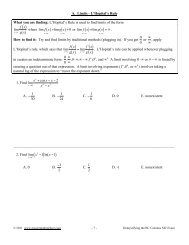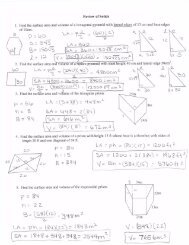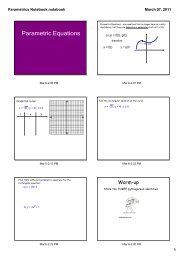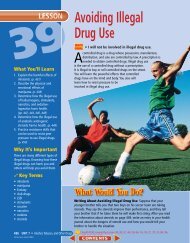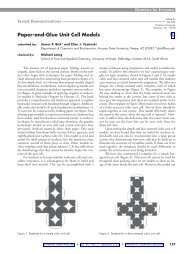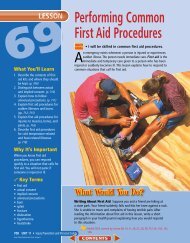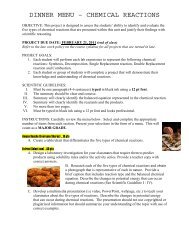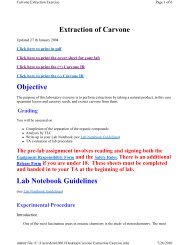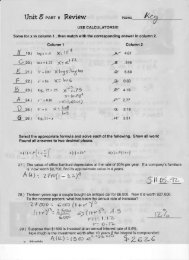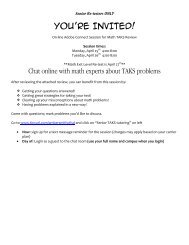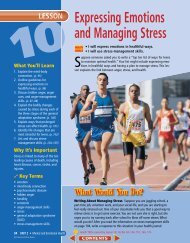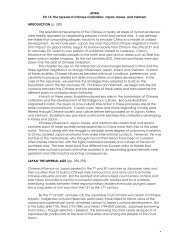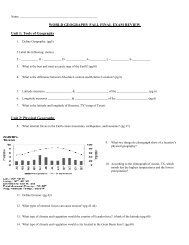Osmosis Tiered Lesson
Osmosis Tiered Lesson
Osmosis Tiered Lesson
Create successful ePaper yourself
Turn your PDF publications into a flip-book with our unique Google optimized e-Paper software.
Name: ________________________________________ Period: ___ Date: ____________________<br />
<strong>Osmosis</strong> Worksheet-Straight Ahead<br />
Introduction. The cell membrane is a semi-permeable structure. Semi-permeable means that some - but not all - particles can<br />
move freely through the membrane barrier without using energy. Large, complex molecules like proteins and carbohydrates,<br />
are too large and cannot move through the membrane without energy. Water, however, can move freely through the membrane<br />
using a type of diffusion called osmosis.<br />
Storyboard #1: The image below demonstrates what happens to a cell when placed in a solution of sugar and water.<br />
1. Compared to the Initial cell, the Final cell looks much different. Keeping in mind the information provided in the<br />
introduction, what do you think caused the cell to change shape?______________________________________<br />
___________________________________________________________________________________________<br />
Storyboard #2: The image below demonstrates what the molecules were doing inside and outside the cell from Question #1.<br />
Inside cell<br />
Cell<br />
Membrane<br />
Outside Cell<br />
Initial Intermediate Final<br />
Hypotonic<br />
(Least sugar concentration)<br />
(Greatest sugar concentration)<br />
Hypertonic<br />
Initial<br />
Intermediate<br />
Key: Water: Sugar:<br />
2. Using the storyboard above, describe what happed to the cell from Question #1 at the particle level.<br />
_________________________________________________________________________________________________<br />
` _________________________________________________________________________________________________<br />
Final<br />
3. The environment on the inside of the cell has a different sugar concentration than the outside of the cell. In each<br />
picture, identify which side of the cell membrane (external or internal) has the greatest concentration of sugar. The first<br />
one has been done for you as an example.<br />
4. The internal and external environments of the cell can be compared using the following terminology – hypertonic,<br />
hypotonic, and isotonic. Define these terms in your own words below. Then label the internal and external<br />
environments in each of the pictures using the terms you defined. The first one has been done for you as an example.<br />
Hypotonic: _______________________________________________________________________________<br />
Isotonic: _______________________________________________________________________________<br />
Hypertonic: _______________________________________________________________________________
Storyboard #3<br />
Observe the completed portion of the storyboard below. Identify the internal and external solutions as isotonic, hypotonic or<br />
hypertonic in the initial, immediate, and final stages. Then write a one sentence explanation about what occurred between the<br />
two molecules.<br />
Internal<br />
Cell<br />
Membrane<br />
External<br />
Key: Water: Sugar:<br />
5. This is what I think is happening:___________________________________________________________________<br />
Storyboard #4<br />
Internal<br />
Cell<br />
Membrane<br />
External<br />
Key: Water: Salt:<br />
6. This is what I think is happening:__________________________________________________________________<br />
Discussion Questions<br />
Initial<br />
Initial<br />
Intermediate<br />
Intermediate<br />
7. Based on what you have completed in this investigation, explain what “diffusion of water” means. __________________<br />
_________________________________________________________________________________________<br />
8. Living systems try to maintain homeostasis. Define homeostasis, and then explain how the cells in your storyboard<br />
reached homeostasis. _______________________________________________________________________________<br />
__________________________________________________________________________________________________<br />
__________________________________________________________________________________________________<br />
9. Based on what you observed in storyboard on question #5, describe how the sugar and water behave once they reach<br />
equilibrium. ________________________________________________________________________________________<br />
__________________________________________________________________________________________________<br />
10. The explanation below was made by a student after observing Storyboard #3.<br />
“I think the water molecules are moving in to make the numbers of particles<br />
equal on both side of the cell membrane.”<br />
Evaluate whether this statement is true or false. Then, justify your answer.<br />
__________________________________________________________________________________________________<br />
__________________________________________________________________________________________________<br />
__________________________________________________________________________________________________<br />
Final<br />
Final
Name: ________________________________________ Period: ___ Date: ____________________<br />
<strong>Osmosis</strong> Worksheet - Uphill<br />
Introduction. The cell membrane is a semi-permeable structure. Semi-permeable refers to the property which allows some - but<br />
not all - particles to move freely through the membrane barrier without the assistance of energy. Large, complex molecules like<br />
proteins and carbohydrates are too large and cannot penetrate this barrier unless energy is present. Water, however, can move<br />
freely through the membrane using a diffusive process called osmosis.<br />
Storyboard #1: Shows over time what happens to a cell when placed in a solution of sugar and water.<br />
1. Compared to the Initial cell, the Final cell looks much different. Keeping in mind the information provided in the<br />
introduction, what do you think caused the cell to change shape?______________________________________<br />
___________________________________________________________________________________________<br />
Storyboard #2: The image below demonstrates what the molecules were doing inside and outside the cell from Question #1.<br />
Inside cell<br />
Cell<br />
Membrane<br />
Outside Cell<br />
Initial Intermediate Final<br />
Initial<br />
Intermediate<br />
Key: Water: Sugar:<br />
2. Using the storyboard above, describe what happed to the cell in Question #1 at the molecular. Explain why you think this<br />
occurred._________________________________________________________________________________________<br />
` _________________________________________________________________________________________________<br />
Final<br />
3. The environment on the inside of the cell contains a different sugar concentration than the outside of the cell. In each<br />
picture, identify which side of the cell membrane (external or internal) has the greatest concentration of sugar.<br />
4. The internal and external environments of the cell can be compared using the following terminology – hypertonic,<br />
hypotonic, and isotonic. Define these terms in your own words below. Then label the internal and external environments<br />
in each of the pictures using the terms you defined.<br />
Hypotonic: _______________________________________________________________________________<br />
Isotonic: _______________________________________________________________________________<br />
Hypertonic: _______________________________________________________________________________
Storyboard #3<br />
Observe the completed portion of the storyboard below. Identify the internal and external solutions as isotonic, hypotonic or<br />
hypertonic in the initial, immediate, and final stages. Then write a one sentence explanation about what occurred between the<br />
two particles.<br />
Internal<br />
Cell<br />
Membrane<br />
External<br />
Intermediate<br />
Key: Water: Sugar:<br />
5. This is what I think is happening:___________________________________________________________________<br />
Storyboard #4<br />
Complete the storyboard below showing how the particles will move in order to achieve equal internal and external saltwater<br />
concentrations. Then record a one sentence summary telling what occurred in the storyboard.<br />
Internal<br />
Cell<br />
Membrane<br />
External<br />
Initial<br />
Initial<br />
Intermediate<br />
Key: Water: Salt:<br />
6. This is what I think is happening:___________________________________________________________________<br />
Discussion Questions<br />
7. <strong>Osmosis</strong> is the diffusion of water. Identify another example of diffusion you have experienced firsthand and explain what<br />
occurred in the process as it was happening. _____________________________________________________________<br />
__________________________________________________________________________________________________<br />
__________________________________________________________________________________________________<br />
8. Living organisms need to maintain a state of balance. What characteristic of life describes balance in an organism?<br />
Explain how the cells in the storyboards achieved a state of balance. ___________________________________________<br />
__________________________________________________________________________________________________<br />
__________________________________________________________________________________________________<br />
9. Based on what you observed in storyboard on question #5, describe how the sugar and water behave once they reach<br />
equilibrium. ________________________________________________________________________________________<br />
__________________________________________________________________________________________________<br />
10. The explanations below were made by two students after observing Storyboard #3.<br />
DeAndre:“I think that the diagrams represent diffusion across the cell membrane and that the liquid is<br />
hypertonic because the sugars don’t move across.”<br />
Madison:“The water wants to move out of the cell by osmosis because there are fewer water molecules outside<br />
the cell compared to inside.”<br />
Which of the students are correct? DeAndre______ Madison______ Both______ Neither______<br />
Explain your answer in paragraph format on an attached sheet of notebook paper.<br />
Final<br />
Final



